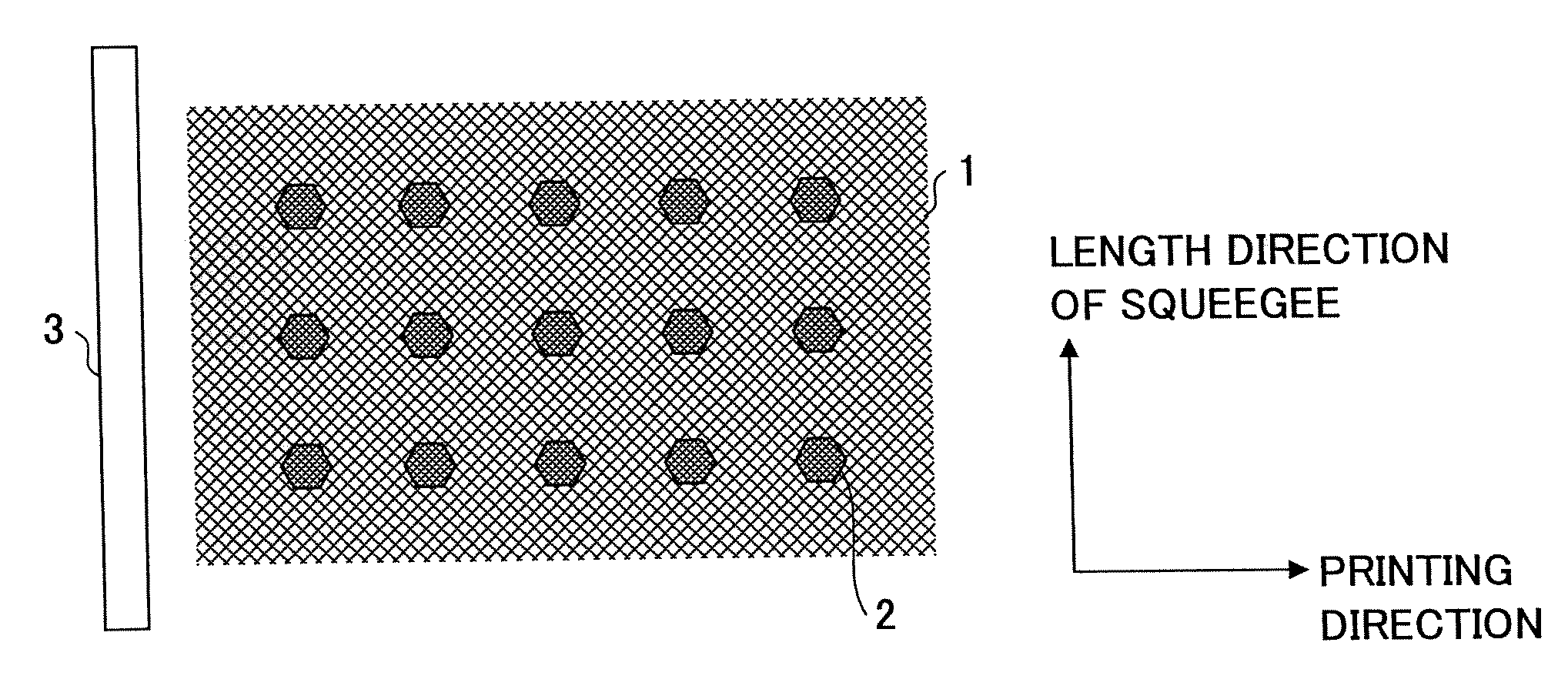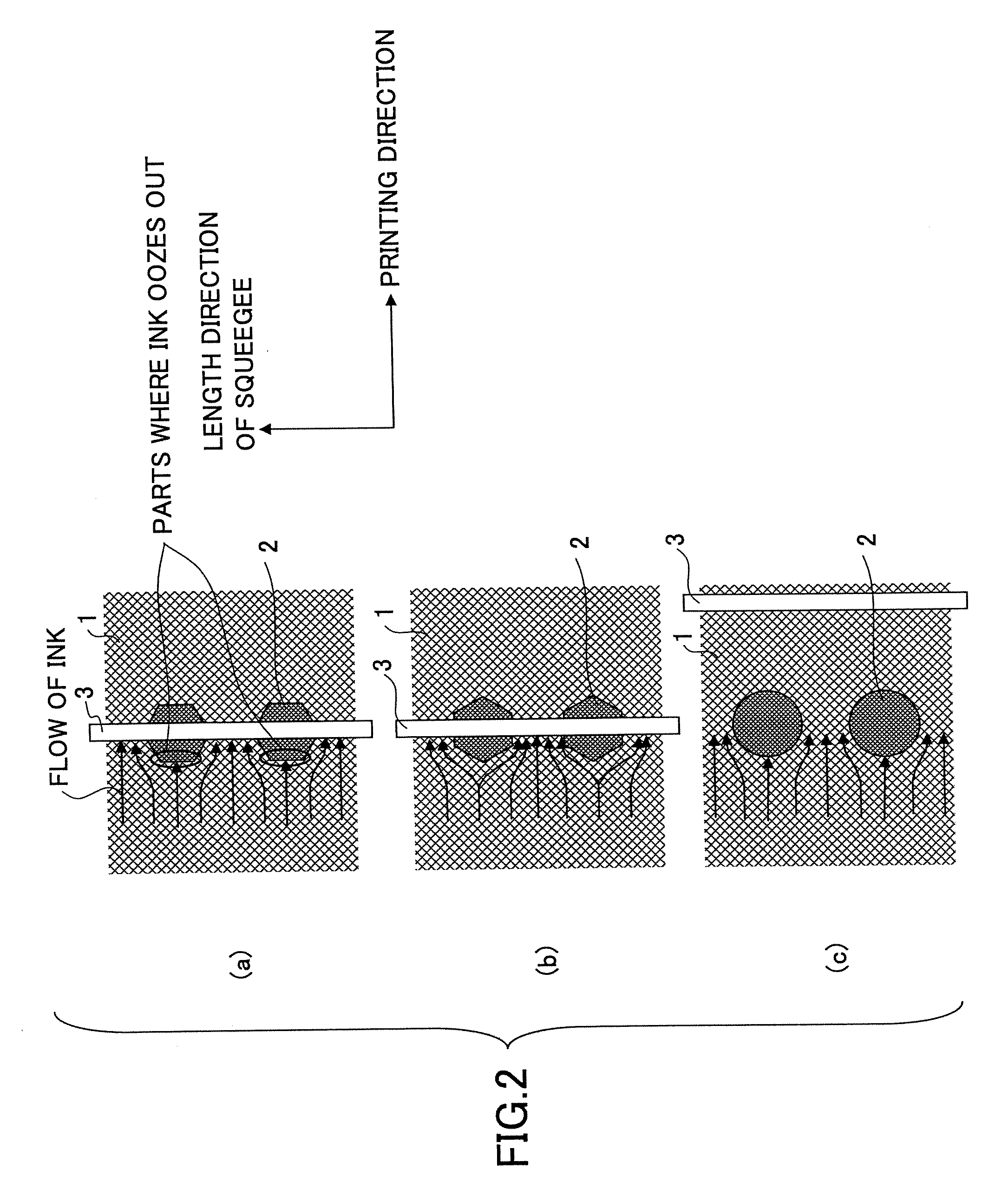Screen printing plate
a printing plate and thick film technology, applied in the direction of foil printing, printing, coating, etc., can solve the problems of large number of steps for using organic insulation film, disadvantage in cost, and inability to form through holes
- Summary
- Abstract
- Description
- Claims
- Application Information
AI Technical Summary
Benefits of technology
Problems solved by technology
Method used
Image
Examples
example 1
[0042]There was employed, as the screen printing plate, one in which the square through-hole patterns 2, 200 μm on a side, were arranged in a matrix form at intervals of 400 μm (see FIG. 4) on the mesh 1 (200 mm×200 mm) having a wire diameter of 23 μm and an opening ratio of about 50%. Note that the through-hole patterns 2 are axisymmetric with respect to the axis in the printing direction as shown in FIG. 4 and have the apex with which the squeegee first comes in contact. Furthermore, the through-hole patterns 2 were by formed by exposing, developing, and drying a mesh coated with a photosensitive emulsion via a photomask having the through-hole patterns formed thereon.
[0043]After being printed with the screen printing plate and a thick film paste in the printing direction as shown in FIG. 4, a polycarbonate film substrate (220 mm×220 mm) having a thickness of 120 μm was dried for 60 minutes at 100° C. to obtain a thick film. Note that there was employed, as the thick film paste, o...
example 2
[0047]Except that the through-hole patterns 2 of the screen printing plate as shown in FIG. 4 were changed to circular through-hole patterns having a diameter of 200 μm as shown in FIG. 6A, a thick film was formed in the same manner as Example 1. Note that the through-hole patterns are axisymmetric with respect to the axis in the printing direction as shown in FIG. 6A and have the apex with which the squeegee first comes in contact.
[0048]On the entire surface of the obtained thick film, there were formed through-holes having a shape substantially the same as that of the through-hole patterns. The formed through-holes were 160 μm long×160 μm wide on average.
example 4
[0056]Nano-silver ink was formed on a polycarbonate substrate by an ink jet method and then dried to form gate electrodes. Next, a gate insulation film was formed by applying thermal polymerization polyimide thereto by a spin coating method and thermal-treating it at 190° C. The formed gate insulation film had a relative permittivity of 3.6 and a film thickness of 0.4 μm. Ultraviolet rays were applied to the areas, on which source / drain electrodes will be formed via a photomask, to modify the surface of the areas. In addition, nano-silver ink was formed on the areas by the ink jet method and then dried to form the source / drain electrodes. Next, an organic semiconductor material expressed by the structural formula
was dissolved in xylene to form ink. The resulting ink was formed into a film by the ink jet method to form an organic semiconductor layer, thereby obtaining organic transistors. The organic transistors thus obtained had a channel length of 5 μm and a channel width of 2 mm.
[...
PUM
 Login to View More
Login to View More Abstract
Description
Claims
Application Information
 Login to View More
Login to View More - R&D
- Intellectual Property
- Life Sciences
- Materials
- Tech Scout
- Unparalleled Data Quality
- Higher Quality Content
- 60% Fewer Hallucinations
Browse by: Latest US Patents, China's latest patents, Technical Efficacy Thesaurus, Application Domain, Technology Topic, Popular Technical Reports.
© 2025 PatSnap. All rights reserved.Legal|Privacy policy|Modern Slavery Act Transparency Statement|Sitemap|About US| Contact US: help@patsnap.com



